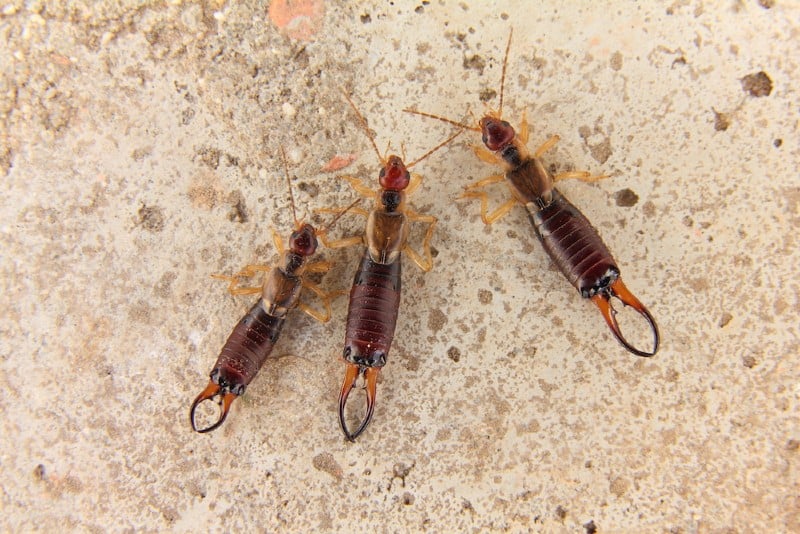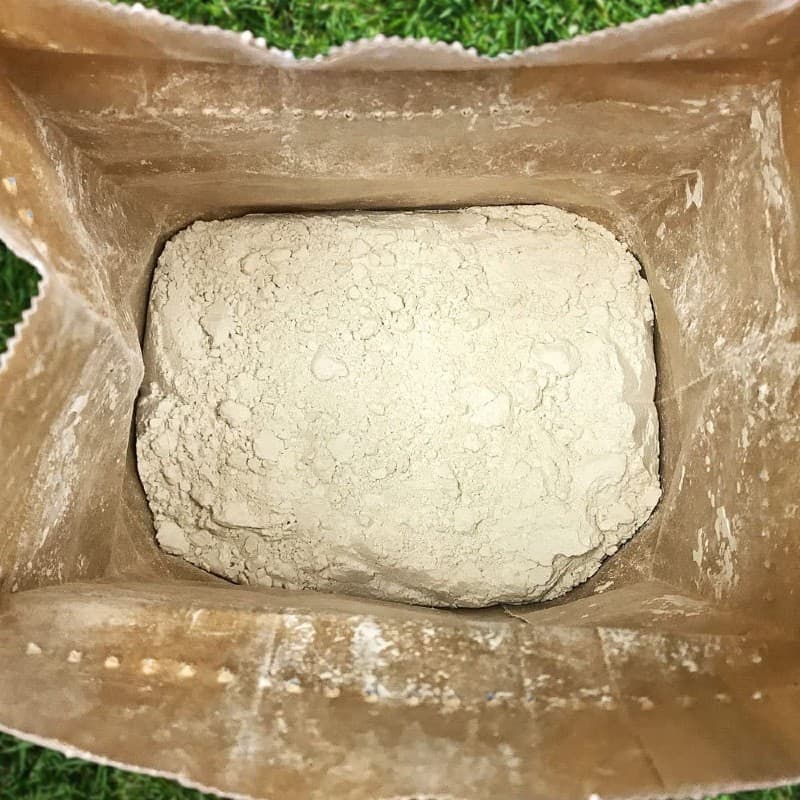When we see earwigs, we might be terrified by their pincers. But they do not hurt humans at all and use pincers for protection. However, people do not like to have any type of infestation inside or near their houses. This article will teach you some useful tricks and define effective solutions for how to get rid of earwigs.
Basic Info about Bugs with Pincers
Here’s what you should learn about the insects you plan to fight. It is important to be aware of their appearance, habitat, and lifestyle to keep them away effectively.
Earwig Identification
Earwigs are insects with pincers or forceps, which are growing from their abdomen. This feature adds a weird look to them. Depending on the species, the sizes of these insects may vary from 5-25 mm. They also have two pairs of wings on their body.
Earwigs are usually black or brown, sometimes with stripes or reddish heads and limbs. They may seem like cockroaches, but you can tell the difference. Earwigs have six legs and pincers, and they do not spread as fast as roaches.
Earwigs are night insects that eat other insects, sometimes moss, fungi, or lichens. Also, they can consume organic materials like mulch, piles, or leaves. During the day, they hide. At the same time, these insects are attracted to light. For habitat, they mostly prefer wet and quiet areas. If the conditions are too good for them, earwigs can spread around the garden and provoke infestation.
Sure, a bug with pincers might look scary. However, earwigs do not carry any poison or diseases. The main concern about these insects is superstitious that they can crawl into your ears.
What Are Earwigs Attracted to in Your Yard or House

As I have said, earwigs are active at night, and they tend to stay in warm and moist places. In your yard, insects can be spotted under pots, rocks, or in the piles, mulch, and wooden litter. They can also live under the porches and homes.
They can sneak to the house in search of a warm and damp environment, especially when the weather is chilly and dry. They often hang out near the leaking pipes or arrange their habitat in the A/C unit. Basements with high humidity and garden faucets are one of the most popular places among earwigs.
What are earwigs attracted to apart from the pleasant living conditions? These insects seek food sources – the materials with cellulose, which are declining. In the yard, it can be a mulch or leaf litter. Also, earwigs do not live on plants only. They often eat worms, decaying insects, and even animals.
But in the buildings, they might find it tasty to crawl to the stacks of old books, boxes, or other paper materials. In the kitchen, sweet or greasy products will be their attraction.

How to Get Rid of Earwigs in Your Territory
The procedure of getting rid of earwigs consists of two main parts.
Step 1. Identifying earwigs
To identify these landscape pests, you need to spot brown-reddish insects, which are 3/4-inch long with pincers. They can also fly sometimes. As they prefer decaying materials as their food, you can detect them near wooden or leaf litter.
However, in some cases, they can consume living plants, fruits, and vegetables. Female insects lay their eggs underground for protection, so it is complicated to find them and prevent infestation. Check the places where these pests can hide, like under the pots or in the basements. They are active at night, so they will seek hiding places near the source of food.
Step 2. Applying natural and chemical treatment
Now let’s deal with the problem of how to exterminate earwigs. As soon as you have detected the signs of infestation, you can apply one of the following treatments:
- Attract birds
The birds might assist you with an infestation, as they like to eat insects and earwigs in particular. Bring birds to your yard with some feeders. They will start coming to your place regularly, attacking pests in your garden. This is the safest and messless way to get rid of insects.
- Set oil and soy sauce traps
In case of a minor level of infestation, you can trap the insects with the DIY traps. You will need a jar or a container with a lid. Mix the equal parts of vegetable oil and soy sauce.
Make small holes in the lid suitable for earwigs to enter and place the container under the ground leaving the top at the ground level. The insects will be attracted by the smell of the sauce, but the oil will not let them crawl up.
- Apply alcohol spray
This contact spray is made of 70% Isopropyl Alcohol and water, mixed in equal proportions. Spray it around your home, its foundation, or in the garden near flowerbeds and trees. The alcohol will ruin insects’ shells, killing them. It is allowed to use the mixture at home, but be careful with plants.
This product is used for dealing with digestive issues, and it leads to loss of moisture. But for small creatures, it is too strong. Spread the thin layer of this treatment in your garden or yard. As soon as the pests crawl on it, the earth starts sucking the water out of them, and the small sharp particles will damage their shells. This works with earwigs and other garden pests.
- Spread the neem oil
This natural insecticide contains a chemical called Azadirachtin, which prevents insects from growing up and breeding. It also affects their feeding habits, so they die. To apply this method, you need to mix this oil with warm water and apply the mixture in the yard, garden, and at the entry points of your house.
Pay more attention to the dark and moist areas. Repeat this 2-3 times a week to achieve results.

- Use chemical insecticides
In case any of the previous methods do not work, you can apply harsh chemical insecticides. However, keep in mind that it is a short-term solution for fast action. To maintain the result, you should apply safer options after.
Common insecticide ingredients
Most chemical insecticides contain deltamethrin and cyfluthrin as active ingredients, which are known to be the most effective ways to keep earwigs away. They are allowed to be used outside for creating a barrier for pests.
Also, some products may be based on bifenthrin, synthetic pyrethrin, or natural components and repellents.
[su_note note_color=”#e5e2d4″]Related post: How to Get Rid of Pill Bugs [/su_note]
Top 5 Best Earwigs Treatments
You might be overwhelmed with the selection of treatments used for earwig control measures. I have decided to help you in choosing the right option for your home or garden. Below you will find 5 best options for cleaning your territory from the earwigs and other pests.
1. Best Earwig Killer from Rockwell Labs: LambdaStar Insecticide
[amazon box=”B007EC692U” template=”vertical” tracking_id=”how-to-get-rid-of-earwigs-20″ button_text=”Check price on Amazon” button_detail=”https://shareasale.com/r.cfm?b=410159&u=2583381&m=43235&urllink=www%2Edomyown%2Ecom%2Flambdastar%2Dultracap%2D97%2Dp%2D14241%2Ehtml%3Fsub%5Fid%3D17939&afftrack=how%20to%20get%20rid%20of%20earwigs” button_detail_text=”Check price on DoMyOwn”]
Specifications:
- Active Ingredient: Lambda-Cyhalothrin 9.7%
- Item Form: Liquid, Spray
- Item Weight: 1.26 pounds
- Item Dimensions LxWxH: 2.05 x 4.25 x 7.85 inches
- Target Species: Ants, Bedbugs (adults and nymphs), Bees, Boxelder Bugs, Carpenter Bees, Carpet Beetles, Centipedes, and others
This is the best earwig insecticide, which you can apply both inside and outside your home. It adheres to the surfaces ensuring long-term protection from various bugs and pests. It has an easy-to-mix formula, which also increases its effectiveness.
This is the best earwig killer considering results. The minor complaint is that it might leave stains if it is not dissolved properly.
| Pros: | Cons: |
|
|
2. Best Earwig Killer: Diatomaceous Earth
[amazon box=”B00025H2PY” template=”vertical” tracking_id=”how-to-get-rid-of-earwigs-20″ button_text=”Check price on Amazon”]
Specifications:
- 100% Organic
- No Contaminants
- Item Form: Powder
- Item Weight: 10.3 pounds
- Item Dimensions LxWxH: 16 x 9 x 7 inches

Diatomaceous Earth is known as one of the best natural killers. It contains only 100% food-grade organic components. That is why you should not worry; it will contaminate the soil. Apart from being an effective anti-bug treatment, this product has a wide range of applications.
Famous for effective killing pincher bugs, this product might attract some insects before killing them eventually.
| Pros: | Cons: |
|
|
3. Earwig Trap from Bell: Trapper Insect Trap
[amazon box=”B002Y6JHES” template=”vertical” tracking_id=”how-to-get-rid-of-earwigs-20″ button_text=”Check price on Amazon” button_detail=”https://shareasale.com/r.cfm?b=410159&u=2583381&m=43235&urllink=www%2Edomyown%2Ecom%2Ftrapper%2Dmonitorinsect%2Dtrap%2Dtm2600%2Dcase%2D100%2Dtraps%2Dp%2D1122%2Ehtml%3Fsub%5Fid%3D4755&afftrack=how%20to%20get%20rid%20of%20earwigs” button_detail_text=”Check price on DoMyOwn”]
Specifications:
- Color: White
- Material: Cardboard
- Item Weight: 0.48 Pounds
- Item Dimensions LxWxH: 9.15 x 8.4 x 0.6 inches
- Target Species: Insects
These non-poisonous traps capture the insects, and they die being glued. You can use this product as one large trap or divide it into three smaller ones. Just stick the trap in the place where pests are spotted and wait until they are collected. There is a plank area on the trap where you can write down the date and the location for monitoring.
But keep in mind that any earwig trap will attract the insects first, so do not place it if there are not any obvious signs of infestation.
| Pros: | Cons: |
|
|
4. Earwig Control from MG Chemicals: Isopropyl Alcohol Spray
[amazon box=”B004SPJP5O” template=”vertical” tracking_id=”how-to-get-rid-of-earwigs-20″ button_text=”Check price on Amazon”]
Specifications:
- Active Ingredient: Isopropyl Alcohol
- Item Form: Luquid, Spray
- Item Volume: 16 fl. oz.
- Item Weight: 15.87 Ounces
- Item Dimensions LxWxH: 3 x 3 x 9 inches
fighting bugs outside as well as inside. You just need to dissolve the alcohol with water. This is one of the less toxic chemical treatments, which does not harm soil and water.
The side effect of this pincher bug killer spray is that it can harm some plants when applied in the garden. To make sure your plants are safe, try the mixture on the small leaf and wait for a day to see what will be the response.
| Pros: | Cons: |
|
|
5. Natural Earwig Repellent from Neem Bliss: Neem Seed Oil
[amazon box=”B0716JF8MB” template=”vertical” tracking_id=”how-to-get-rid-of-earwigs-20″ button_text=”Check price on Amazon”]
Specifications:
- Active Ingredient: Neem Oil 100%
- Material Feature: Organic
- Item Volume: 16 fl. oz.
- Package Weight: 1 pounds
- Package Dimensions LxWxH: 5.91 x 3.98 x 1.93 inches
If you want to repel insects with completely natural treatment, the neem oil is your choice. It is easy to use as it needs only warm water to create a spray mixture. It is a natural repellent, which is safe for the environment and biodegradable. Neem oil works against numerous insects.
Being a natural earwig repellent, neem oil is also known as a strong allergen. So do not apply it near pets, children, or in places with bad ventilation.
| Pros: | Cons: |
|
|
How to prevent earwigs in your yard in the future
After applying one of the treatments, you might see the results and feel relaxed. However, pests can get back as soon as the insecticide effect ends. That is why you should take preventive measures as well to keep insects away.
In the yard and garden, you should do regular cleaning up. Get rid of old logs, piles, and decorative stones, especially if they are near the house foundation. Also, maintain this area dry and mulch free, taking away dry leaves and other organic materials. Trim trees and bushes by cutting the dry and dead branches.
Make sure there is a decent drainage system around your house. Eliminate the number of outdoor lights in order not to attract insects. Prevent pests from crawling inside by placing the repair screens on vents. Set the dehumidifier in the damp basement.
Now you also know how to repel earwigs from your yard and home.
[su_note note_color=”#e5e2d4″]Related post: How to Get Rid of Asian Beetles [/su_note]
FAQ About Earwig Control
Here’s more information about earwigs and how to deal with them.
Why do I have so many earwigs in my house?
Earwigs enter your house for the following reasons:
- They look for more comfortable conditions when the weather changes;
- They are attracted with the light outside and inside the house;
- They are spreading near the foundation and gradually enter your house.
What will kill earwigs?

When the preventive methods do not work, and the level of infestation is growing, learn how to kill earwigs with fast-working chemical insecticides.
There are a lot of options but focus more on treatments that have the following active ingredients: azadirachtin, diatomaceous earth, bifenthrin, pyrethrins, etc. Usually, they come in the form of a spray, which you should apply near the plants or other areas where their habitat is.
[su_note note_color=”#e5e2d4″]Related post: Best Grub Killers [/su_note]
Are earwigs harmful to humans?
They might look scary because of pincers, but they are completely harmless to humans. They will not sting or bite you, and they do not carry any poison. They also will not crawl into your ears, despite the common beliefs.
What can I do about earwigs in my house?
Apply the suitable treatment in case of serious infestation, clean the yard, and apply solutions there if you spot the pests. Maintain the cleanness of your dwelling and the territory. Keep the basement clean and dry as well.

Find Your Best Way to Get Rid of Pincher Bugs
Despite the absence of danger from earwigs, hardly any of us wants to have an uncontrolled infestation of any kind. That is why it is important to take measures as soon as you spot any signs of damage. There are many solutions, so you can find the best way to get rid of pincher bugs that will be effective in your case.
How do you fight the earwigs and other pests in your yard and home? Share the most effective solutions according to your experience.
References:
- Pests of Landscape Plants (College of Agriculture, Food and Environment):
https://entomology.ca.uky.edu/landscape - Diatomaceous Earth (Oregon State University):
http://npic.orst.edu/factsheets/degen.html
